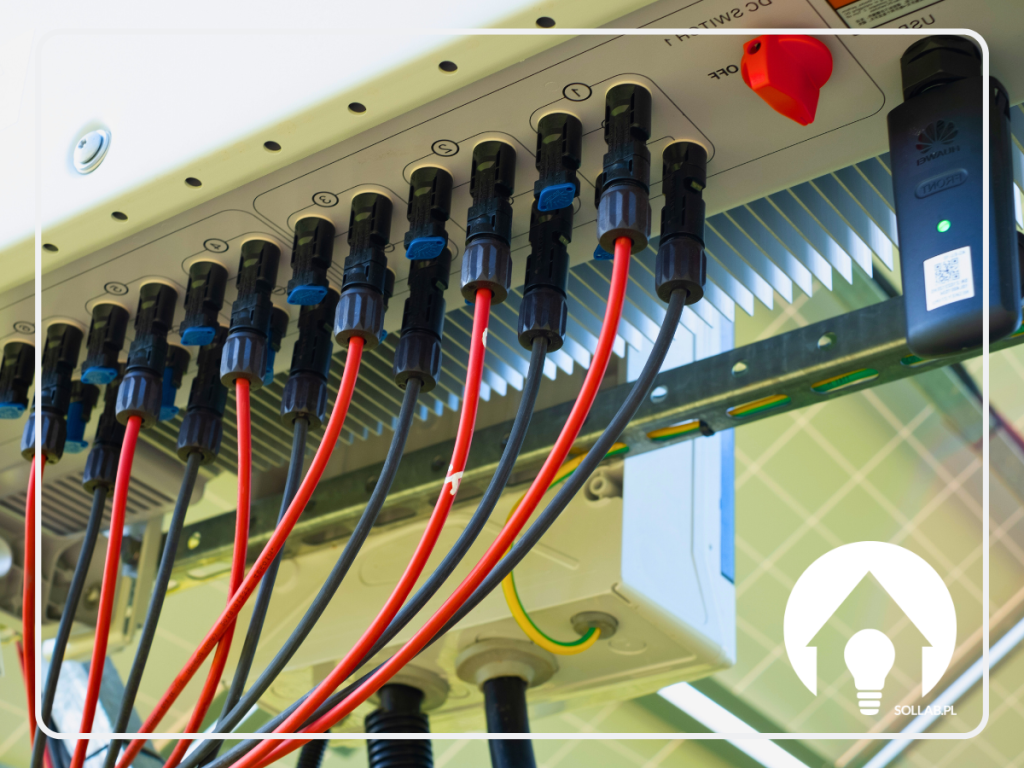Photovoltaics on the ground - what does this type of investment involve?
Photovoltaics on the ground is an increasingly popular way of harnessing renewable energy sources. This form of investment involves installing photovoltaic panels directly on the ground instead of on the roofs of buildings. What do you need to know about ground-mounted photovoltaics? What are the advantages of this solution? How do I prepare for the investment? In this article, you will find the answers to all these questions and many more! Welcome!
What is photovoltaics on the ground?
Ground-mounted photovoltaics are an innovative system using solar panels placed on dedicated mounting structures that are firmly anchored to the ground. These installations are characterised by a high degree of size flexibility - they can occupy small sections of plots of land or extend over large areas, creating extensive photovoltaic fields. It all depends on energy needs and space availability.
Similar to roof-mounted PV systems, ground-mounted systems consist of PV modules, cabling, an inverter and a support structure. Their main purpose is to produce electricity from the sun's rays, regardless of the installation location. The key difference is the location: ground-mounted PV systems require a suitably large site. Household plots are often chosen for this purpose, but also larger areas if a photovoltaic farm is planned. This solution makes efficient use of the available space while contributing to the production of green energy.
A photovoltaic system installed on the ground functions in a similar way to those installed on roofs. An important aspect of such an installation is to precisely match its output to the current energy needs. In order to determine the required system size, it is crucial to analyse past electricity bills to assess average energy consumption. It is important that the potential increase in energy demand in the future is also taken into account during planning, adding a certain margin to the calculation. Such a power margin will ensure that the photovoltaic system will be able to meet increasing demands, which is particularly important in terms of increasing energy efficiency and the long-term performance of the installation.
Why Photovoltaics on Land?
Ground-mounted photovoltaics are becoming increasingly popular, and their choice as an energy source has a number of compelling advantages. Firstly, ground-mounted locations allow for optimal positioning of solar panels, resulting in higher energy efficiency than rooftop panels, which are limited by the design and orientation of the roof. Secondly, ground-mounted installations offer much greater flexibility in terms of scaling, allowing the system to be easily expanded as energy needs increase. In addition, ground-mounted solar PV is an excellent solution for areas unsuitable for other uses, such as wasteland or degraded areas, contributing to their revitalisation. This form of energy generation is also less invasive to the structure of buildings, which is important especially for older structures. Taking these aspects into account, ground-mounted photovoltaics appear to be an attractive alternative to traditional methods of energy generation, both economically and environmentally, helping to promote sustainable development.
Ground-mounted photovoltaics, in addition to the already mentioned advantages such as higher energy efficiency, flexibility of scaling and the possibility of using wasteland, have many other benefits. Here are some of them:
- Improved exposure to ssun: Panels installed on the ground can be positioned at an ideal angle to the sun, increasing their efficiency compared to roof-mounted panels, which are limited by the angle of the roof.
- Easier konservation: Access to panels on the ground is usually easier than those on roofs, making maintenance, cleaning and possible repairs easier.
- Minimising the risk of damage dachu: Mounting the panels on the ground eliminates the risk of roof damage that may occur during the installation or operation of the photovoltaic system.
- Reducing cshadowing: Panels on the ground can be positioned in such a way as to avoid shading by trees or buildings, a common problem with roof panels.
- Use of poor quality grunts: On-ground systems can be installed on land that is not suitable for agriculture or other purposes, making efficient use of space.
- Greater scalability: Ground-based systems can be easily expanded, which is attractive for large-scale projects such as solar farms.
- Better conditions ccooling: Photovoltaic panels operate more efficiently at lower temperatures. Mounting on the ground often provides better cooling conditions than on the roof.
- Less impact on aesthetics budynki: Installation on the ground does not affect the appearance of buildings, which can be important for buildings of particular architectural interest.
- Reduction of eCO2 missions: Like other forms of renewable energy, on-ground PV contributes to the reduction of greenhouse gas emissions, supporting climate change targets.
What challenges should be taken into account?
There are many benefits to installing solar PV on the ground, but at the same time there are various challenges that need to be considered before starting the project. Here are some of the key issues:
- Site selection: The location should be carefully considered in terms of sunlight availability, direction and slope. It is important that the site is not shaded by trees or other structures.
- Environmental impact: Photovoltaic installations can affect local ecosystems. The potential impact on biodiversity should be considered, especially if installation is planned in naturally valuable areas.
- Investment costs: Ground-mounted installation may require a larger initial investment than roof-mounted systems, especially in terms of site preparation, installation of supporting structures and cabling.
- Maintenance and Safety: Systems on the ground are more accessible, which makes maintenance easier, but can also increase the risk of vandalism or theft. This requires appropriate security measures.
- Space requirements: Large ground-mounted PV systems require significant space, which can be problematic in densely built-up or agricultural areas.
Where to mount the inverter for a ground-mounted photovoltaic installation?
Choosing where to install the inverter in a ground-mounted photovoltaic system requires careful consideration of both technical and practical aspects. The inverter, which converts direct current from the solar panels into alternating current, should be located as close to the panels as possible to minimise energy losses. At the same time, it is important that it is easily accessible both for connection to the electricity grid and for maintenance purposes.
Protection from the weather is crucial, even though many inverters are designed for outdoor use. Additional protective measures can ensure that the unit is safe from intense sunlight, rain or snow. Equally important is the provision of adequate ventilation to avoid overheating of the inverter.
What is the cost of building photovoltaics on the ground
The cost of a ground-mounted photovoltaic installation can vary significantly depending on a number of factors. The main elements affecting the price include:
- Installation size: The cost is closely linked to the size of the installation, measured in kilowatts (kW). The larger the installation, the higher the total cost will be, although the price per kilowatt may fall for larger projects due to economies of scale.
- Quality of Solar Panels: Solar panels vary in price according to their efficiency and durability. Higher-end panels, offering better efficiency and longer life, will be more expensive.
- Type of Supporting Structure: Load-bearing structures, which must be robust and weatherproof, can vary in price depending on material and construction.
- Inverter system: The price of an inverter depends on its power and functionality. Advanced inverters with additional features, such as monitoring capabilities or integration with energy management systems, can be more expensive.
- Installation costs: Labour costs for installation may vary depending on the specifics of the project.
- Additional Groundwork: Site preparation for the installation, will also affect the final cost.
Because of all these variables, it is difficult to give a clear price for a photovoltaic installation on land. The cost can range from a few tens of thousands of zloty for a small domestic installation to millions of zloty for large photovoltaic farms. Therefore, the best solution is to get an individual quote from a specialist Sollab company. Our specialists will help to take into account all the specific requirements and conditions of a given project
What is a carport?
Carports have similar advantages to classic ground-mounted installations. This innovative combination of a traditional carport with modern photovoltaic technology transforms simple parking spaces into ecological and functional installations.
Equipped with solar panels on the roof, photovoltaic carports offer protection for vehicles from the weather while producing electricity. This energy can be used to power the home, office, charge electric vehicles and even feed into the public grid, providing savings on electricity bills and helping to reduce CO2 emissions.
In addition to the practical and ecological aspects, photovoltaic carports can also be an interesting architectural feature. Their modern and modular designs allow them to be customised to suit individual needs and the aesthetics of their surroundings, adding value to both private and commercial properties. They are ideal for those who want to maximise the use of available space, especially when the roof of the building is not suitable for the installation of solar panels.
Photovoltaic carports are also crucial to the development of electromobility. Equipping them with electric vehicle charging stations makes them even more functional, allowing vehicles to be charged directly from renewable energy sources. This solution is particularly attractive for companies and institutions, which can thus offer additional facilities for their employees and customers, while promoting green values.
All in all, photovoltaic carports represent a creative and effective symbiosis between modern technology and everyday needs, reflecting the growing environmental awareness and drive towards sustainability. More than just a parking space, they are a step towards a future in which renewable energy is an integral part of our lives.
Summary
The future of ground-mounted photovoltaics is promising and a key element in the global transition to sustainable energy sources. With each passing year, the technology is becoming more accessible, efficient and economically viable, resulting in its growing popularity among both private homeowners and businesses.
As technology develops and costs fall, on-ground solar PV has the potential to become a major source of renewable energy. Its ability to make efficient use of unsuitable agricultural or degraded land, combined with its high scalability and ability to meet growing energy needs, makes it particularly attractive.
In summary, the future of photovoltaics on the ground promises to be one of the most dynamic and influential spheres in the field of renewable energy sources, with great potential to contribute to sustainable and green development worldwide.
















